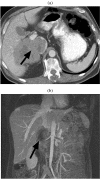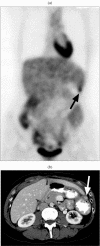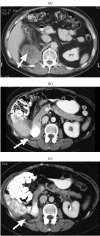Retroperitoneal sarcomas
- PMID: 16154826
- PMCID: PMC1665230
- DOI: 10.1102/1470-7330.2005.0019
Retroperitoneal sarcomas
Abstract
Retroperitoneal sarcomas are rare neoplasms. CT or MR imaging is performed in patients with these tumors to detect local extent and distant metastases of the tumor and for preoperative surgical planning. Most sarcomas cannot be characterized as to cell type with CT or MR, with the exceptions being liposarcomas and intracaval leiomyosarcomas. Similarly histological grading cannot be made definitively with imaging alone, the exception being liposarcoma since well differentiated liposarcomas contain more macroscopic fat than do less differentiated liposarcomas. After surgery, follow up imaging with CT or MR and careful scrutiny of the tumor bed and resection site are essential to detect early recurrences, which can often be managed with re-resection.
Copyright International Cancer Imaging Society.
Figures







References
-
- Mettlin C, Priore R, Rao U. Results of the national soft tissue sarcoma registry. J Surg Oncol. 1982;19:224–7. - PubMed
-
- McGrath P. Retroperitoneal sarcomas. Semin Surg Oncol. 1994;10:364–8. - PubMed
-
- Daugaard S. Current soft tissue sarcoma classification. Eur J Cancer. 2004;40:543–8. - PubMed
-
- Coindre JM, Mariani O, Chibon F, et al. Most malignant fibrous histiocytomas developed in the retroperitoneum are dedifferentiated liposarcomas: a review of 25 cases initially diagnosed as malignant fibrous histiocytomas. Mod Pathol. 2003;16:256–62. - PubMed
-
- Papanicolaou N, Yoder IC, Lee MJ. Primary retroperitoneal neoplasms: How close can we come in making the correct diagnosis. Urol Radiol. 1992;14:221–8. - PubMed
MeSH terms
LinkOut - more resources
Full Text Sources
Medical
